
Minutes before clouds gathered over the night sky, astrophotographer Matt Pollock caught this snapshot of the Milky Way.
Pollock took the image on March 3, 2016 from Cherry Plain State Park in Petersburg, New York.
"Despite gathering clouds and the rapid approach of dawn, I managed to hike in, set up my tripod and align my Astro Track to the north star and get the 3 shots spaced 60 degrees apart necessary to capture the full arch of our home galaxy with its core peeking out through the haze, clouds and incoming fog," Pollock wrote in an email to Space.com.
The Milky Way is a spiral galaxy stretching between 100,000 and 120,000 light-years in diameter. It is estimated that the galaxy has approximately 400 billion stars. The brighter stars of the summer triangle are located in the center segment of the arch. The three bright orbs on the lower right are Saturn, Antares and Mars, which appears larger than normal due to a fog bank rolling in from the southeast causing light diffusion as well as the camera filter Pollock used for this image. [Simple Stargazing: Explore the Milky Way ] Pollock used a Nikon D800 with modded Baader filter, Niikon 16-35mm lens @ 16mm and a double fog filter. The night sky objects were tracked for 200 seconds at F4, ISO 800 and the foreground was taken during civil dawn at F6.3, 1/6th of a second at ISO 160.
Editor's note: If you have an amazing night sky photo you'd like to share with Space.com and our news partners for a possible story or image gallery, please contact managing editor Tariq Malik at spacephotos@space.com.
Original story on Space.com.
Sign up for the Live Science daily newsletter now
Get the world’s most fascinating discoveries delivered straight to your inbox.











